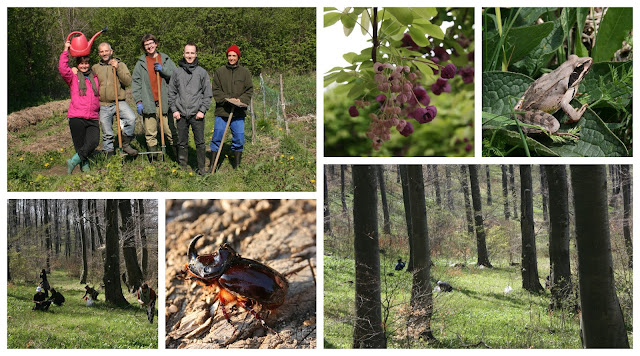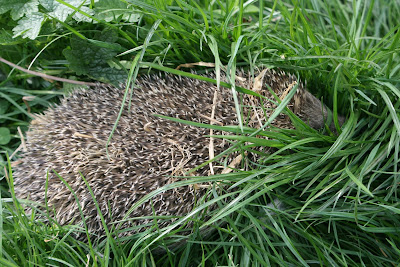It's been a busy week here, getting the last of the trees and shrubs planted around the gardens and preparing beds for the annuals. We also had an open day last weekend and was great to meet people from all over Bulgaria with shared interests in regenerative gardening. At the end of the week we started our Design and Build a Forest Garden Course and had a great time with an awesome group. I'll write a post on the course and the garden we created during the course in the coming weeks.
It's been sunny and warm for the first time this month and a good opportunity to get a team photo of the polyculture study crew. Misha, Philip, Eileen, Ronan and Lia (left to right) have been doing an amazing job in the gardens this season.
 |
| Plants, Seeds, eBooks, Consultancy, Bulk Fruit and Nut Tree Orders for Permaculture, Polyculture, Forest Gardens and Regenerative Landscapes. |
Ataraxia
Forest Garden Maintenance - November last year we created a 150 m2 forest garden in Ataraxia during our Design and Build Course (you can read about how we created this garden in a previous post here). The plants are establishing well although it seems the shrub layer has been under attack from rabbits during the winter with some browsing damage evident. Forest gardens require little maintenance when they are young, but do need close observation and some important tasks carried out from time to time. For example, last week we added some more mulch to the plants and removed some of the grasses that were starting to grow at the base of the plants and may likely compete with the establishing plants for mineral nutrients, light and water.
Here is an illustration of how the mature Forest Garden should look.
 |
| Forest Garden |
Lia and Ronan planted out Asparagus officinalis - Asparagus and Fragaria x ananassa - Strawberry for ground cover in a deep mulched raised bed we made last June. The soil is beautiful. You can read about how we created this raised bed last June in a previous post here.
The bed was full of what I think are Prunus cerasifera - Cherry Plum seedlings. The seeds most probably got there from the manure we applied to the bed last year. Cherry Plums are abundant in this area and grazing animals will gobble them up from under the trees. The seedlings should make great root stocks for grafting so I've potted them up.
In case your interested, we've been adding some new stuff to our online store
|
Apatheia - Home Garden
Akebia quinata - Chocolate Vine, so impressive this time of year :) The beautiful flowers feed the bees for 3 - 4 weeks and transform into odd looking edible fruits by mid October. We grow this plant up an arbor to provide shade to the bio-nursery plants during high summer.
A late ripening apple tree in our garden is always the last apple to blossom. I think it's a Granny Smith. Delicious, crunchy, sweet with a hint of acidity, one of my favourite apples.
Local native Alliaria petiolata has spread nicely around the garden. This biennial flowering plant is from the mustard family, Brassicaceae and when picked young makes a nice addition to the salad bowl. The flowers are also extremely attractive to a range of solitary bees.
Ribes nigrum cv.- Blackcurrant blossoms are transforming into fruits, looks like it will be a good year for currants.
Philip with bags of goodies - edible greens from the Market Garden including Nettles- Urtica dioica - Chickweed - Stellaria media and Rumex spp. known locally as Лапад -(Lapad)
Mountain Hike
We went for a hike up to the beech forests to pick some Wild Garlic - Allium ursinum (also known as buckrams, ramsons, wood garlic or bear's garlic). It was still quite damp in the forest from all the rain fall from the previous weeks, conditions that Fire salamanders (Salamandra salamandra) feel comfortable moving around in. I spotted a few of them on the way up.
About 1.5 km up the mountain the floor of a west facing slope is adorned with a carpet of Allium ursinum - Wild Garlic under the Beech - Fagus sp. trees. We picked bags full for pesto and salads.
Among the wild garlic you can find small patches of this beautiful legume, Spring Vetchling - Lathyrus verna. This nitrogen fixing herbaceous perennial is native to forests of Europe and Siberia. The flowers attract bumblebees among other pollinators.
Wildlife in the Gardens
We found this beautiful European rhinoceros beetle - Oryctes nasicornis in the Nursery compost pile that includes branches and stumps which makes sense as the larvae grow in decaying plants feeding on woody debris. The development period of the larvae can lasts 2 - 4 years with the adult beetle emerging at the end of March, April or May. Adult beetles as shown below only live several months and do not feed relying on reserves accumulated during the larval stages. They will mate and lay eggs before the Autumn.
Me and Dylan came across this Toad - Bufo bufo crossing the field where our new forest garden will be created. It's unusual to see toads out in the open especially around midday. Close inspection of the toad revealed some damage to the animals head. Dylan suggested it may have been caught by a Stork and dropped when the bird was in flight. We moved the toad into some damp shade.
Always a pleasure to see what is in my opinion the most princely of amphibians in our gardens. This Agile Frog - Rana dalmatina leapt across my view and landed in perfect pose on a Symphytum x uplandicum - Comfrey plant.
Regenerative Landscape Design - Online Interactive Course
Want to learn how to design, build and manage regenerative landscapes? Join us for our Regenerative Landscape Design - Online Interactive Course from May 1st to Sep 13th, 2023.
We're super excited about running the course and look forward to providing you with the confidence, inspiration, and opportunity to design, build and manage regenerative landscapes, gardens, and farms that produce food and other resources for humans while enhancing biodiversity.

Regenerative Landscape Design Online Course
You can find out all about the course here and right now we have a 20% discount on the full enrollment fees. Just use the promo code RLD2023 in the section of the registration form to receive your discount.
We are looking forward to providing you with this unique online learning experience - as far as we know, the very first of its kind. If you are thinking of reasons why you should do this course and whether this course is suitable for you, take a look here where we lay it all out. Looking forward to it!
We're super excited about running the course and look forward to providing you with the confidence, inspiration, and opportunity to design, build and manage regenerative landscapes, gardens, and farms that produce food and other resources for humans while enhancing biodiversity.
 |
| Regenerative Landscape Design Online Course |
You can find out all about the course here and right now we have a 20% discount on the full enrollment fees. Just use the promo code RLD2023 in the section of the registration form to receive your discount.
We are looking forward to providing you with this unique online learning experience - as far as we know, the very first of its kind. If you are thinking of reasons why you should do this course and whether this course is suitable for you, take a look here where we lay it all out. Looking forward to it!
--------------------------------------------------------------------------------------------------------------------------
Support Our Project
If you appreciate the work we are doing you can show your support in several ways.
- Make a purchase of plants or seeds from our Bionursery or Online Store
- Consider joining us for one of our Courses or Online Courses
- Comment, like, and share our content on social media.
- Donate directly via PayPal to balkanecologyproject@gmail.com or via FTX Pay
If you appreciate the work we are doing you can show your support in several ways.
- Make a purchase of plants or seeds from our Bionursery or Online Store
- Consider joining us for one of our Courses or Online Courses
- Comment, like, and share our content on social media.
- Donate directly via PayPal to balkanecologyproject@gmail.com or via FTX Pay
 |
| You can also register for our online training, services, and products directly here. |







































